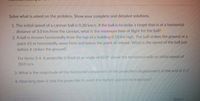
College Physics
11th Edition
ISBN: 9781305952300
Author: Raymond A. Serway, Chris Vuille
Publisher: Cengage Learning
expand_more
expand_more
format_list_bulleted
Concept explainers
Topic Video
Question

Transcribed Image Text:Solve what is asked on the problem. Show your complete and detailed solutions.
1. The initial speed of a cannon ball is O.20 km/s. If the ball is to strike a target that is at a horizontal
distance of 3.0 km from the cannon, what is the minimum time of flight for the ball?
2. A ball is thrown horizontally from the top of a building 0.10 km high. The ball strikes the ground at a
point 65 m horizontally away from and below the point of release. What is the speed of the ball just
before it strikes the ground?
For items 3-4. A projectile is fired at an angle of 60.0° above the horizontal with an initial speed of
30.0 m/s.
3. What is the magnitude of the horizontal component of the projectile's displacement at the end of 2 s?
4. How long does it take the projectile to reach the highest point in its trajectory?
Next
Expert Solution
This question has been solved!
Explore an expertly crafted, step-by-step solution for a thorough understanding of key concepts.
This is a popular solution
Trending nowThis is a popular solution!
Step by stepSolved in 2 steps with 2 images

Knowledge Booster
Learn more about
Need a deep-dive on the concept behind this application? Look no further. Learn more about this topic, physics and related others by exploring similar questions and additional content below.Similar questions
- Hey im stuck on this question You are on the plane neptune and want to determine the acceleration due to gravity, g. You have a stopwatch and a toy gun that can launch a ping pong ball vertically upwards with an initial velocity of 7.5 m/s. Describe, in words, how you would perform an experiment to determine the acceleration due to gravity. Be sure to describe the variables you would measure, the equations you would use and the assumptions you would make. Make sure to include a diagram of the physical situation, label know and unknown quantities with units, coordinate system. Please use grade 12 kinematics and label the variables as v1, v2, a (Acceleration), t (time), d (displacement) Thanks!arrow_forwardProjectile Motion and Relative Motion 1. You want to see if you can throw a rock across a ravine that is 19.4 m wide. The other side of the cliff is 5.9 m below your side. You throw the rock at 12.1 a. How much time does it take for the rock to travel the horizontal distance between the two edges of 45° above the horizontal. the ravine? b. What is the vertical position of the rock at this time?arrow_forwardProjectile motion A projectile is launched from the origin, which is a point 50 ft from a 30-ft vertical cliff (see figure). It is launched at a speed of 50√2 ft/s at an angle of 45° to the horizontal. Assume the ground is horizontal on top of the cliff and that only the gravitational force affects the motion of the object.a. Give the coordinates of the landing spot of the projectile on the top of the cliff.b. What is the maximum height reached by the projectile?c. What is the time of flight?d. Write the integral that gives the length of the trajectory.e. Approximate the length of the trajectory.f. What is the range of launch angles needed to clear the edge of the cliff?arrow_forward
- Constant Velocity problemarrow_forwardI need help with thesearrow_forwardA ball is thrown at an initial height of 90 feet at an initial velocity of 55 feet/second at an angle of 75 degrees. Given the parametric equations y = 16t2 + Vo · Sin(0)t + ho and r = Vo Cos(0)t. When doing calculations, carry 5 digits of accuracy, so your round off does not build up. a. What is the ball's height in 3 seconds? feet. b. When will the object hit the ground? seconds. c. How far horizontally will the ball be when it hits the ground? feet. d. When will the ball be at its maximum height? seconds. e. What is the ball's maximum height? feet. f. How far horizontally will the ball be when it reaches its maximum height? feetarrow_forward
arrow_back_ios
arrow_forward_ios
Recommended textbooks for you
 College PhysicsPhysicsISBN:9781305952300Author:Raymond A. Serway, Chris VuillePublisher:Cengage Learning
College PhysicsPhysicsISBN:9781305952300Author:Raymond A. Serway, Chris VuillePublisher:Cengage Learning University Physics (14th Edition)PhysicsISBN:9780133969290Author:Hugh D. Young, Roger A. FreedmanPublisher:PEARSON
University Physics (14th Edition)PhysicsISBN:9780133969290Author:Hugh D. Young, Roger A. FreedmanPublisher:PEARSON Introduction To Quantum MechanicsPhysicsISBN:9781107189638Author:Griffiths, David J., Schroeter, Darrell F.Publisher:Cambridge University Press
Introduction To Quantum MechanicsPhysicsISBN:9781107189638Author:Griffiths, David J., Schroeter, Darrell F.Publisher:Cambridge University Press Physics for Scientists and EngineersPhysicsISBN:9781337553278Author:Raymond A. Serway, John W. JewettPublisher:Cengage Learning
Physics for Scientists and EngineersPhysicsISBN:9781337553278Author:Raymond A. Serway, John W. JewettPublisher:Cengage Learning Lecture- Tutorials for Introductory AstronomyPhysicsISBN:9780321820464Author:Edward E. Prather, Tim P. Slater, Jeff P. Adams, Gina BrissendenPublisher:Addison-Wesley
Lecture- Tutorials for Introductory AstronomyPhysicsISBN:9780321820464Author:Edward E. Prather, Tim P. Slater, Jeff P. Adams, Gina BrissendenPublisher:Addison-Wesley College Physics: A Strategic Approach (4th Editio...PhysicsISBN:9780134609034Author:Randall D. Knight (Professor Emeritus), Brian Jones, Stuart FieldPublisher:PEARSON
College Physics: A Strategic Approach (4th Editio...PhysicsISBN:9780134609034Author:Randall D. Knight (Professor Emeritus), Brian Jones, Stuart FieldPublisher:PEARSON

College Physics
Physics
ISBN:9781305952300
Author:Raymond A. Serway, Chris Vuille
Publisher:Cengage Learning

University Physics (14th Edition)
Physics
ISBN:9780133969290
Author:Hugh D. Young, Roger A. Freedman
Publisher:PEARSON

Introduction To Quantum Mechanics
Physics
ISBN:9781107189638
Author:Griffiths, David J., Schroeter, Darrell F.
Publisher:Cambridge University Press

Physics for Scientists and Engineers
Physics
ISBN:9781337553278
Author:Raymond A. Serway, John W. Jewett
Publisher:Cengage Learning

Lecture- Tutorials for Introductory Astronomy
Physics
ISBN:9780321820464
Author:Edward E. Prather, Tim P. Slater, Jeff P. Adams, Gina Brissenden
Publisher:Addison-Wesley

College Physics: A Strategic Approach (4th Editio...
Physics
ISBN:9780134609034
Author:Randall D. Knight (Professor Emeritus), Brian Jones, Stuart Field
Publisher:PEARSON